
Troup County is a county located in the west central portion of the U.S. state of Georgia. As of the 2020 census, the population was 69,426. The county seat is LaGrange.
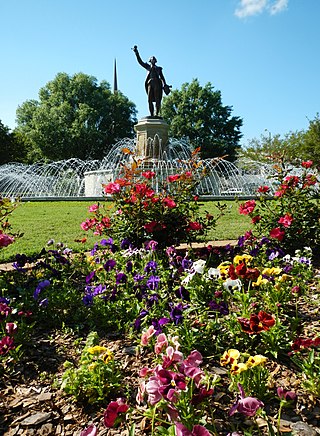
LaGrange is a city in and the county seat of Troup County, Georgia, United States. The population of the city was estimated to be 30,858 in 2020 by the U.S. Census Bureau. It is the principal city of the LaGrange, Georgia Micropolitan Statistical Area, which is included in the Atlanta-Sandy Springs-Gainesville, Georgia-Alabama (part) Combined Statistical Area. It is about 60 miles (97 km) southwest of Atlanta and located in the foothills of the Georgia Piedmont.

The Bulloch County Courthouse is a historic courthouse that is located in downtown Statesboro, Georgia. It was built in 1894 to house the county government. On September 18, 1980, the building was added to the National Register of Historic Places.
A Mississippi Landmark is a building officially nominated by the Mississippi Department of Archives and History and approved by each county's chancery clerk. The Mississippi Landmark designation is the highest form of recognition bestowed on properties by the state of Mississippi, and designated properties are protected from changes that may alter the property's historic character. Currently there are 890 designated landmarks in the state. Mississippi Landmarks are spread out between eighty-one of Mississippi's eighty-two counties; only Issaquena County has no such landmarks.
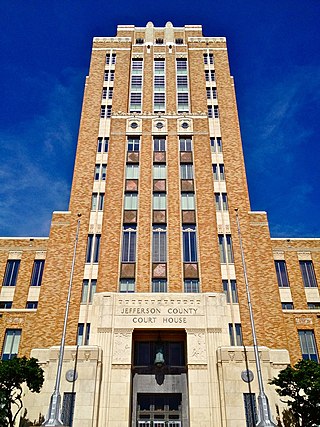
The Jefferson County Courthouse in Beaumont, Texas is one of the tallest courthouses in the state, and is an excellent example of Art Deco architecture. Built in 1931, it is the fourth courthouse built in Jefferson County. It was designed by Fred Stone and Augustin Babin, and is thirteen stories high. In 1981, an annex was added to the west side of the courthouse.

The Contra Costa County Superior Court, officially known as the Superior Court of California, County of Contra Costa, is the branch of the California Superior Court with jurisdiction over Contra Costa County. It has four courthouses: Martinez, Pittsburg, Richmond and Walnut Creek.
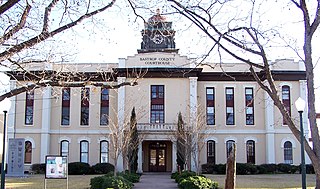
The Bastrop County Courthouse is a historic courthouse built in 1883 at 803 Pine St, Bastrop, Texas. The Renaissance Revival style building was designed by Jasper N. Preston and F.E. Ruffini. It was added to the National Register of Historic Places on November 20, 1975.

The Scott County Jail is the main detention facility for Scott County, Iowa, United States. Inmates are housed for no more than one year, by Iowa law. It is located in the county seat, Davenport, and is part of same facility as the Scott County Courthouse.

The Des Moines County Court House located in Burlington, Iowa, United States, was built in 1940. It was listed on the National Register of Historic Places in 2003 as a part of the PWA-Era County Courthouses of Iowa Multiple Properties Submission. The courthouse is the fourth structure to house court functions and county administration.

The Allamakee County Court House in Waukon, Iowa, United States was built in 1940. It was placed on the National Register of Historic Places in 2003 as a part of the PWA-Era County Courthouses of IA Multiple Properties Submission. The courthouse is the third building the county has used for court functions and county administration.

The Keokuk County Courthouse located in Sigourney, Iowa, United States, was built in 1911. It was individually listed on the National Register of Historic Places in 1981 as a part of the County Courthouses in Iowa Thematic Resource. In 1999 it was included as a contributing property in the Public Square Historic District. The courthouse is the fourth building the county has used for court functions and county administration.

The Ida County Courthouse, located in Ida Grove, Iowa, United States, was built in 1883. It was listed on the National Register of Historic Places in 1974 as a part of the County Courthouses in Iowa Thematic Resource. The courthouse is the second building the county has used for court functions and county administration.
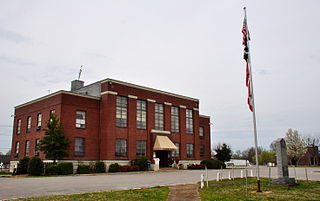
Lewis County Courthouse in Hohenwald, Tennessee is a historic courthouse building built in 1939 that is listed on the National Register of Historic Places.
McDonald Brothers founded in 1878 was a Louisville-based firm of architects of courthouses and other public buildings. It was a partnership of brothers Kenneth McDonald, Harry McDonald, and Donald McDonald.

William J.J. Chase was an American architect of Atlanta, Georgia.
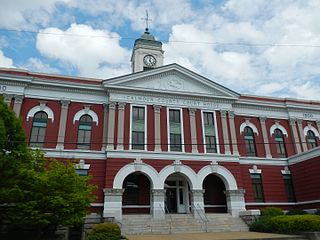
The Calhoun County Courthouse is a historic county courthouse in Anniston, Alabama. It was designed by Atlanta architect J. W. Golucke and built in 1900, when the county seat of Calhoun County was moved from Jacksonville. It is one of the earliest Neoclassical courthouses in Alabama. An annex with a jail was added on the north side of the building in 1924. The courthouse was rebuilt after a 1931 fire, albeit with a slightly different clock tower. A southeastern annex was built in 1963. The building was listed on the National Register of Historic Places in 1985.
Austin Callaway, also known as Austin Brown, was a young African-American man who was taken from jail by a group of six white men and lynched on September 8, 1940, in LaGrange, Georgia. The day before, Callaway had been arrested as a suspect in an assault of a white woman. The gang carried out extrajudicial punishment and prevented the youth from ever receiving a trial. They shot him numerous times, fatally wounding him and leaving him for dead. Found by a motorist, Callaway was taken to a hospital, where he died of his wounds.

The Lagrange Commercial Historic District in LaGrange, Georgia is a 32-acre (13 ha) historic district listed on the National Register of Historic Places. It includes 72 contributing buildings, two contributing sites, and 30 non-contributing buildings.

The Quitman County Courthouse and Old Jail is a historic building in Georgetown, Georgia. It was listed on the National Register of Historic Places in 1995.

The Lynn County Courthouse, on Public Square in Tahoka, Texas in the High Plains region of Texas south of Lubbock, Texas, was built in 1916. It was listed on the National Register of Historic Places in 1982.



















